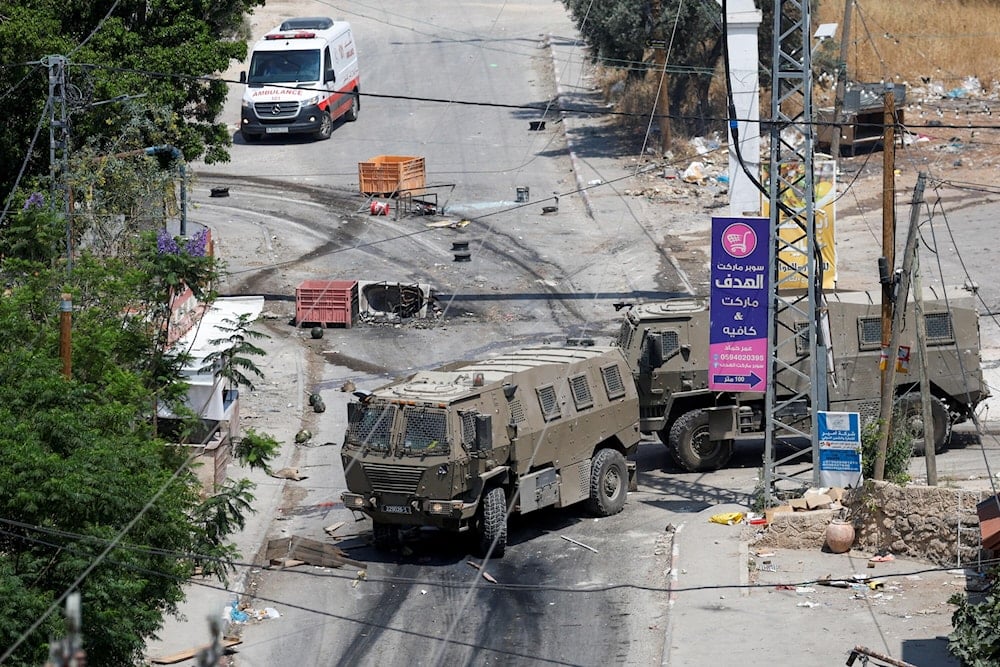'Israel' fears 'Lebanonization' of West Bank Resistance operations
Israeli media cites concerns in the Israeli army and intelligence establishments over the increasing use of IEDs by the Palestinian Resistance in the occupied West Bank.
-

Israeli armored personnel vehicle after being targeted by a Resistance IEDs during the occupation's incursion into Jenin, West Bank, in June 2023. (Social media)
Israeli media reported concerns within the Israeli army and intelligence leadership over the "Lebanonization" of the occupied West Bank, which reminded them of the fighting against Hezbollah in the 1990s during the occupation of southern Lebanon, and the use of explosive devices during that time.
The activities of the Palestinian Resistance in the West Bank have seen significant and notable developments since the Al-Aqsa Flood operation on October 7, with the growing use of IEDs.
Read more: Resistance confronts Israeli incursion in Jenin with IEDs, small arms
Israeli channel Kan TV reported that this has become a major concern as the threat in the West Bank has become more severe recently.
According to the channel, some of the bombs contain tens of kilograms of explosive materials that are detonated remotely, with Resistance fighters planting them under the asphalt on the roads.
Israeli military experts highlighted that the occupation army uses armored bulldozers to clear the streets before other vehicles enter, triggering the explosive devices to detonate upon contact with the bulldozers.
Revised Resistance tactics
For its part, Israeli Channel 12 confirmed that the Resistance developed a new tactic, and is now burying the IEDs deeper into the ground to avoid them being triggered by bulldozers.
Previously, the devices were buried at a depth of ten or more centimeters under roads and pavements. However, recent Israeli incursions into Tulkarm, Jenin, and other West Bank cities have shown that the Resistance has started planting the explosives at depths of a meter or more.
Read more: Israeli occupation kills 13-year-old Palestinian child in West Bank
As a result, according to the channel, the Resistance has successfully detonated IEDs targeting occupation soldiers despite the engineering forces pre-scanning the roads.
Nearly every Israeli incursion into the cities and camps of the West Bank faces the use of explosive devices by the Resistance, which has become a significant "operational burden."
The latest incident involved the Resistance targeting occupation forces with an explosive device around the Nur Shams camp in Tulkarm on July 9. The occupation acknowledged the death of a soldier, the driver of a Nimr vehicle destroyed by resistance fighters in Nur Shams camp, at the beginning of this month.
The latest incident saw the Resistance targeting a military vehicle carrying occupation forces with an explosive device near the Nur Shams camp in Tulkarm on July 9. Earlier this month, the occupation acknowledged the death of a soldier, who was the driver of a Nimr vehicle destroyed by Resistance fighters in an IED attack.
Additionally, Kan TV revealed on July 1 that the explosive devices used by the Resistance over five days resulted in the death of an officer and a soldier and injured 17 others in explosions in Jenin and Tulkarm.
According to Israeli newspaper Yedioth Ahronoth, the occupation army has decided to reduce its exposure to IEDs by intensifying aerial attacks, increasing intelligence surveillance, and banning the entry of fertilizers into the West Bank.

 3 Min Read
3 Min Read










